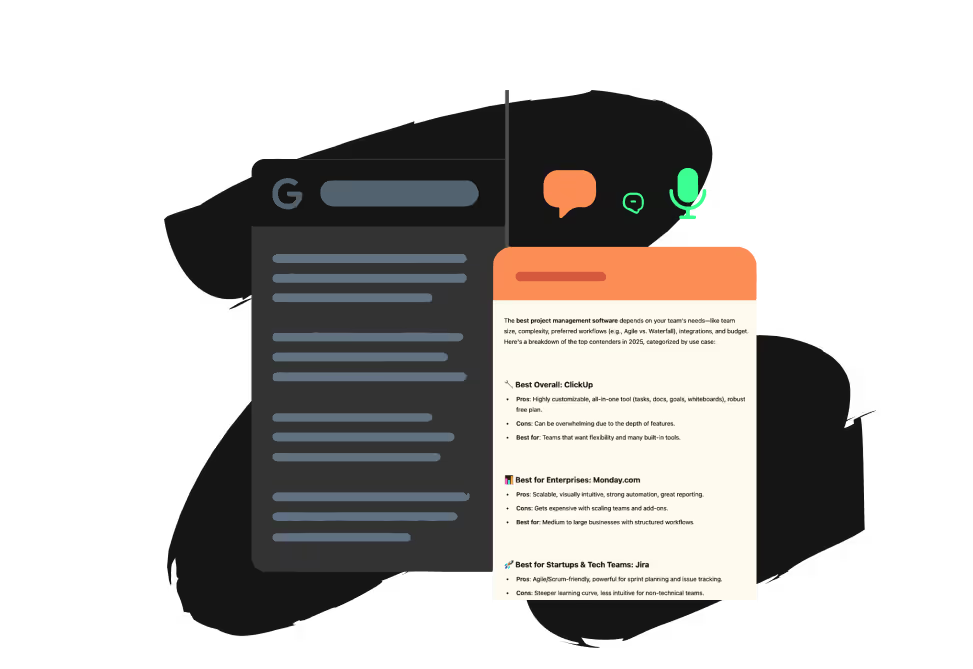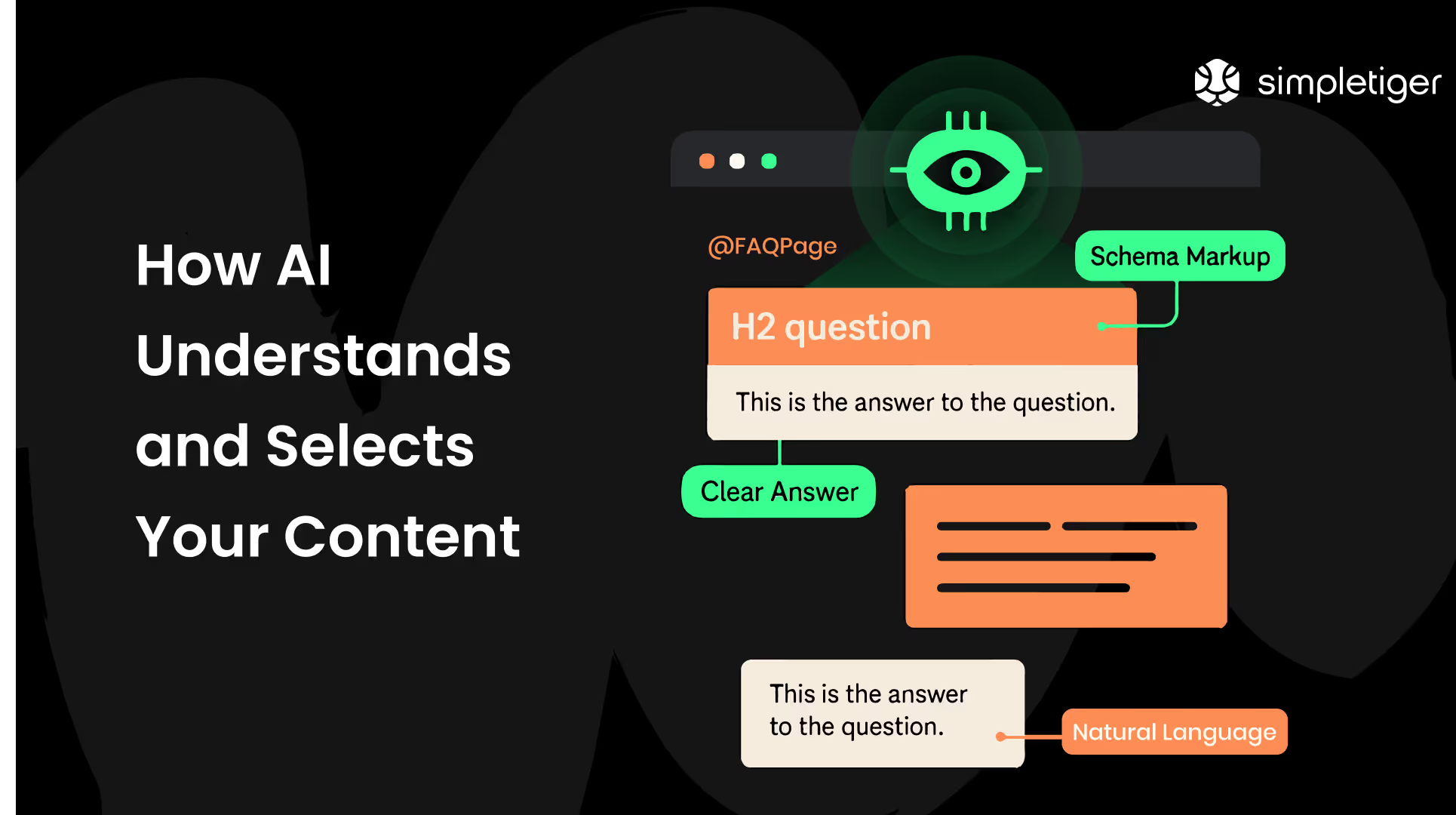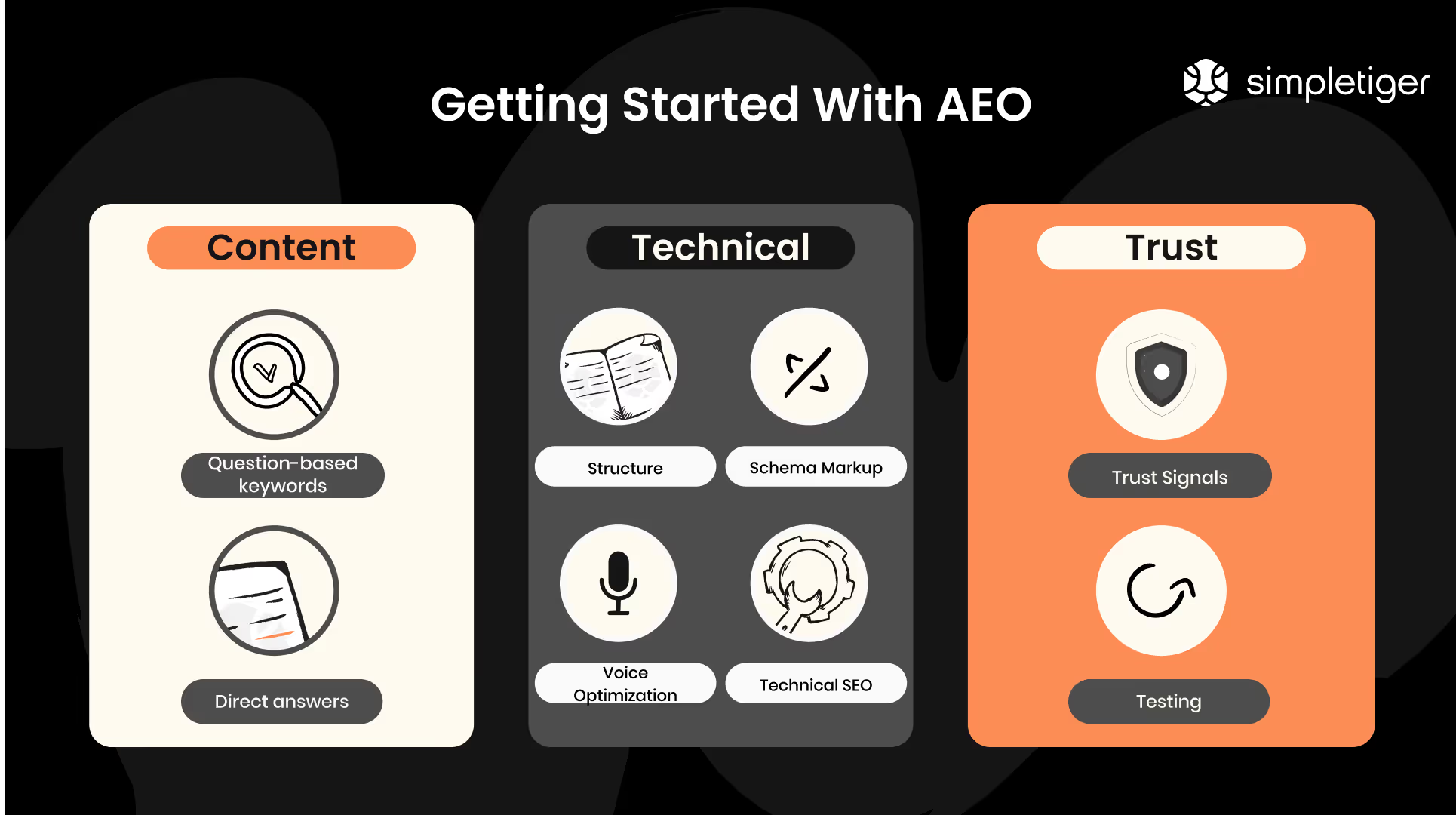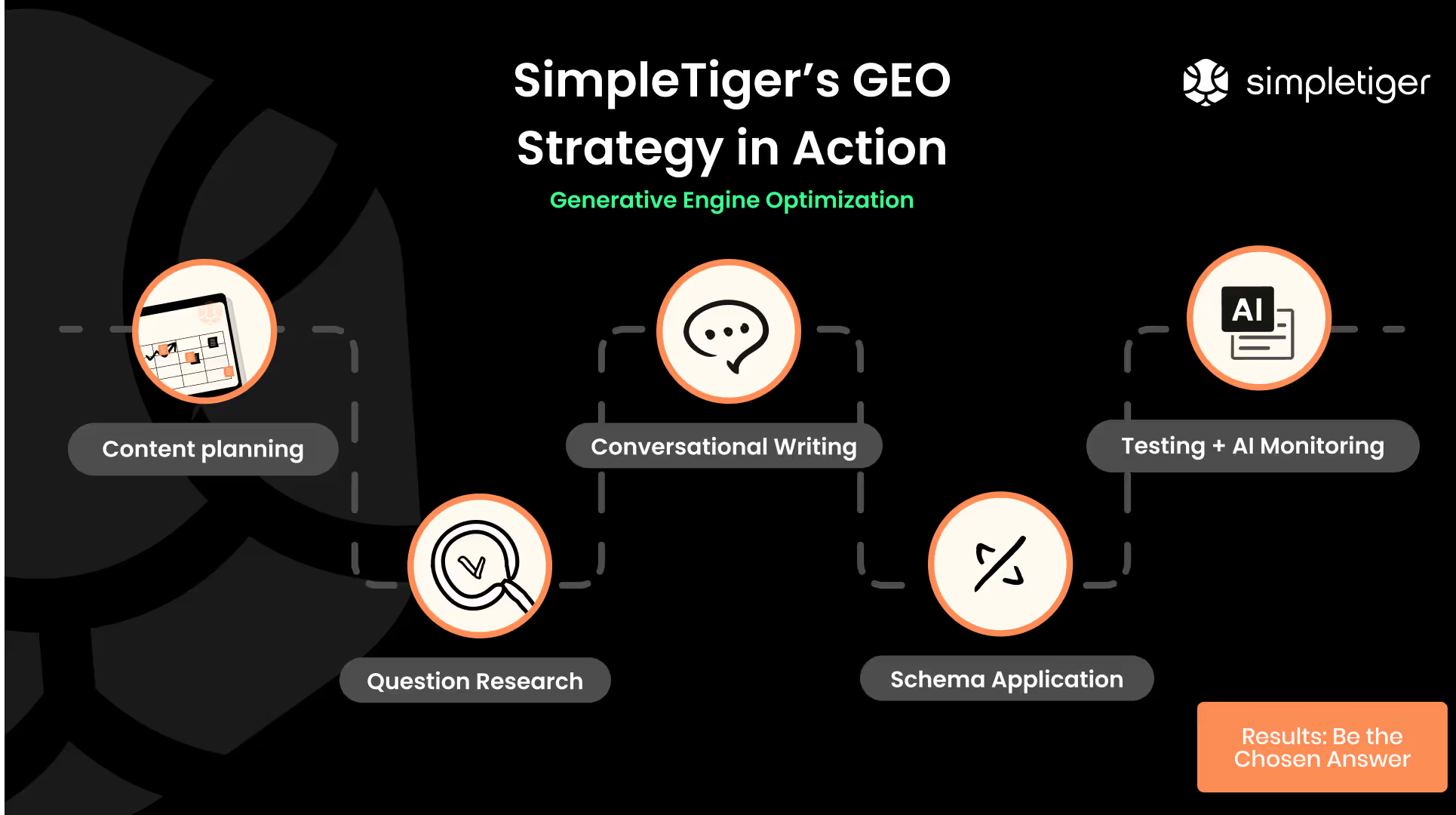Download the SaaS SEO Guide PDF
Over 60+ page SaaS SEO Guide in PDF format so you can read it whenever you want!



Over 60+ page SaaS SEO Guide in PDF format so you can read it whenever you want!







SaaS buyers ask a lot of questions before they ever compare tools. They research how to solve specific problems, explore best practices, and look for guidance that fits their team and tech stack. As they move through this process, they turn to search engines and AI tools to find clear, direct answers.
That's where Answer Engine Optimization becomes essential. AEO helps structure your content so it shows up in those moments. Whether someone is asking an early research question or evaluating solutions more closely, your content is easier for AI to find, understand, and cite as a trusted answer.
In this post, we'll explain what AEO is, how AI systems evaluate your content, and why this approach strengthens your existing SEO. You'll also learn eight specific ways to optimize for AEO so your content stays visible in both search results and AI-powered answers.

Answer Engine Optimization (AEO) is the process of structuring your content so that AI tools can easily find, understand, and cite it. Rather than optimizing just for SERPs, AEO focuses on turning your content into a trusted source for direct answers.
It’s not just about keyword optimization. AEO requires content that:
In an environment where AI delivers the answer itself, AEO helps you stay visible. The goal isn’t just to drive clicks. It’s to be the trusted source AI pulls from, even when there’s no click at all.

Yes, search is evolving. But that doesn’t mean that traditional SEO is obsolete. Organic search still drives the majority of inbound traffic. What’s changed is how users find answers, and your strategy needs to reflect that.
In May 2025, Google shared that AI Overviews are meant to complement search results, not replace them. Content that is clear, useful, and people-first still performs well in both traditional and AI-powered search. That is exactly where AEO comes in. It helps you structure content in a way that works across both formats, so you stay visible no matter how the landscape shifts.
Here’s why AEO should be part of your approach:
In short, AEO doesn’t replace your SEO strategy. It enhances it. By making your content easier for AI to understand and reuse, you keep showing up where it counts no matter how the search landscape shifts.
Below are 8 effective methods to optimize your site and content for AI-powered answer engines.

AI tools prioritize content that directly answers user queries. To get cited, your content needs to match the way people actually ask questions.
Here’s how to find those opportunities:
This type of research sets the foundation for content that answer engines trust and reference, especially in zero-click results.
AI tools and users scan for instant clarity. If your content answers the question right away, it's more likely to be selected for AI responses or featured snippets.
Follow these best practices:
If your content takes too long to deliver value, AI will look for a faster source.
How your content is formatted can be the difference between being featured or overlooked. Featured snippets and AI summaries often pull from pages that are well-organized and easy to scan. A clear structure helps AI tools and voice assistants extract key points faster.
To improve skimmability and snippet potential:
When your content is clean and well-structured, answer engines can identify and feature it more easily. Formatting helps your insights get seen even if the user doesn’t click through to your site.
Schema markup is a form of structured data that gives AI and search engines extra context about your content. It acts as a roadmap that signals what your page is about, whether it's answering a question, explaining a process, or listing a product.
According to Google’s own guidelines, structured data helps pages qualify for enhanced results by clearly communicating what the content is about. Adoption is growing quickly. In 2024, structured data usage increased by 7%, with formats like RDFa and Open Graph now implemented on over 60 percent of websites. This growth reflects a shift from using schema only for SEO to supporting AI engines in delivering reliable, structured answers.
To apply schema effectively:
Structured data is essential for AEO. It helps answer engines determine what your content covers, whether it directly answers a query, and how confidently it can be cited as a trusted result.
AI platforms prefer answers from credible sources. Just like SEO values expertise and accuracy, answer engines favor content that is fact-based, verifiable, and written with clarity.
To build trust with both users and AI:
Trust is one of the strongest signals AI systems look for. When your content consistently delivers reliable answers, it's more likely to be cited and featured.
Voice assistants like Siri, Alexa, and Google Assistant rely on natural, spoken language. These queries are often longer and phrased as full questions. To earn voice visibility, your content needs to match how people speak, not just how they type.
Here's how to optimize for voice-friendly results:
The goal is to create answers that sound natural, feel helpful, and are easy for AI to deliver clearly. That makes your content more likely to be the voice users hear.
Even the best content can be ignored if your site is slow or hard to use on mobile. AI-driven searches often happen on mobile devices or smart assistants that rely on fast-loading content. AEO depends on technical SEO to ensure your content is accessible, fast, and easy to deliver.
Here's how to improve your technical foundation:
Technical SEO is the delivery system behind AEO. If your content loads quickly, works well on mobile, and is easy for AI to access, it has a much better chance of being featured.
Answer Engine Optimization is not a set-it-and-forget-it tactic. Search behavior changes, algorithms evolve, and new opportunities emerge. To maintain and improve your visibility, you need to track performance and make ongoing adjustments.
Here's how to stay proactive:
AEO success depends on staying agile. By reviewing performance and acting on what you learn, you give your content the best chance to be seen, cited, and trusted by AI systems.
SaaS buyers are curious, research-driven, and asking specific, high-intent questions. Not just “CRM software,” but things like: “What’s the best tool for managing remote SaaS teams with Slack integration?”
That’s where AEO makes an impact for SaaS SEO.
It helps your content appear as the direct answer to niche, solution-oriented queries right when a prospect is looking for help. This kind of visibility can influence the entire buyer journey, even before a user clicks or converts.
Most SaaS companies already invest in blogs, guides, and help articles. AEO takes that content and makes it:
In saturated categories, AEO helps you stand out. Especially if your competitors haven’t optimized for AI-driven answers. If your brand shows up in AI snapshots while theirs doesn’t, you’re already ahead.
When an AI assistant summarizes or cites your content, you’re building:

At SimpleTiger, we’ve woven AEO into our SaaS SEO methodology by default, so you’re covered across search and AI platforms.
We call it Generative Engine Optimization (GEO).
Every piece of content we create is designed to:
The goal isn’t to replace traditional SEO. It’s to strengthen it by making sure your content works just as well in a search result as it does in an AI summary.
Book a Discovery Call with SimpleTiger today, and let’s explore how to grow your SaaS through the power of Answer Engine Optimization and AI-driven search. We’ll analyze your current presence, pinpoint opportunities, and chart a clear path to making your brand the go-to answer in 2025 and beyond.
SaaS SEO requires specialized knowledge of complex B2B or B2C SaaS buying cycles, technical product messaging, and conversion optimization for subscription-based business models. It focuses on metrics like MRR, LTV, and CAC, not just traffic or general rankings.
Most specialized SaaS SEO agencies charge monthly retainers, typically ranging from $3,000 to $10,000+, depending on the company size, competition level, and scope of services needed. Some offer project-based SaaS SEO pricing for specific tasks.
Initial improvements, such as technical fixes or on-page optimization for existing content, can show an impact within 2-3 months. However, significant business impact from a comprehensive SaaS SEO strategy, including substantial lead and revenue growth, typically takes 6-12 months as content matures and domain authority builds.
The decision depends on your growth stage, budget, and the breadth of expertise required. An in-house specialist can offer deep product focus, while a SaaS SEO agency provides access to a team with diverse, specialized skills across technical SEO, content, and link building, often bringing broader industry experience and established processes.
Quality SaaS SEO agencies measure success through tangible business outcomes directly impacting revenue. Key metrics include growth in qualified demo requests, trial signups, organic lead generation, improvements in CAC and LTV, and ultimately, increased MRR and sales pipeline growth attributed to organic search.
.avif)
Bella is Content Director at SimpleTiger, responsible for building the strategy, systems, and team that scale content-driven growth for our SaaS clients.
Over 60+ pages detailing how to grow your SaaS company using a proven SEO process.


Schedule a Discovery Call and see how we've helped hundreds of SaaS companies grow!




Actionable insights to help you grow your SaaS and dominate your search market!